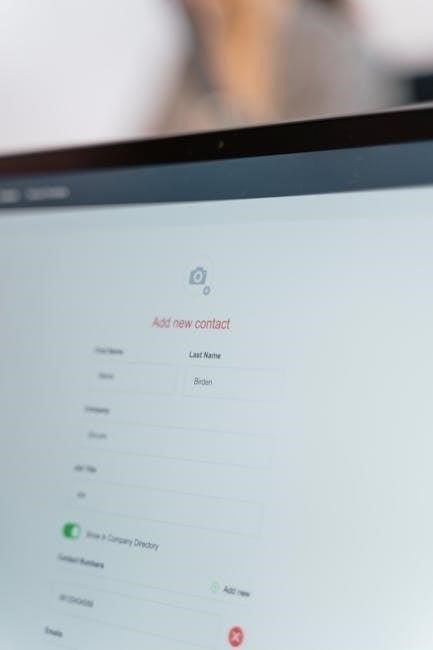Explore our collection of grade 5 and 6 PDF worksheets designed to master adding and subtracting fractions with unlike denominators. These resources align with Common Core standards, offering practice problems and answer keys. Enhance fraction skills today!
Understanding Unlike Denominators
Before diving into adding and subtracting fractions, grasping the concept of unlike denominators is crucial. Unlike denominators refer to fractions where the bottom numbers (denominators) are different. For example, 1/2 and 1/3 have unlike denominators. To perform addition or subtraction, these fractions need a common ground – a shared denominator.
The challenge arises because you can’t directly combine fractions with different sized “pieces.” Imagine trying to add a slice from a pie cut into two pieces (halves) with a slice from a pie cut into three pieces (thirds). The slices are unequal, making direct addition impossible.
Recognizing unlike denominators is the first step. Students should be able to quickly identify whether fractions share a common denominator or not. This foundational understanding paves the way for the next step: finding a common denominator, which allows for meaningful mathematical operations.
Worksheets often start with exercises focused solely on identifying like and unlike denominators to reinforce this essential skill. Mastering this concept ensures a smoother transition to the more complex processes of finding the least common denominator and performing the actual addition or subtraction.
Finding the Least Common Denominator (LCD)
Once you’ve identified fractions with unlike denominators, the next crucial step is finding the Least Common Denominator (LCD). The LCD is the smallest multiple that the denominators of both fractions share. Finding the LCD allows us to rewrite the fractions with a common base, making addition and subtraction possible.
Several methods can be used to find the LCD. One common approach is listing the multiples of each denominator until a common multiple is found. For example, to find the LCD of 1/4 and 1/6, list the multiples of 4 (4, 8, 12, 16…) and the multiples of 6 (6, 12, 18…). The smallest multiple they share is 12, making 12 the LCD.
Another method involves prime factorization. Break down each denominator into its prime factors. The LCD is then found by multiplying together the highest power of each prime factor that appears in either factorization. This method is particularly useful when dealing with larger denominators.
Worksheets often provide practice in finding the LCD using various methods. Mastering this skill is essential because it directly impacts the accuracy of subsequent addition and subtraction operations. Understanding and efficiently calculating the LCD is a cornerstone of fraction manipulation.
Adding Fractions with Unlike Denominators

Adding fractions with unlike denominators requires a preliminary step: converting the fractions to equivalent fractions with a common denominator, specifically the Least Common Denominator (LCD). Once the fractions share the same denominator, addition becomes straightforward.

To add fractions like 1/3 and 1/4, first find the LCD of 3 and 4, which is 12. Next, convert each fraction to an equivalent fraction with a denominator of 12. To convert 1/3, multiply both the numerator and denominator by 4, resulting in 4/12. Similarly, to convert 1/4, multiply both the numerator and denominator by 3, resulting in 3/12.
Now that both fractions have the same denominator, you can add the numerators: 4/12 + 3/12 = 7/12. The denominator remains the same. The result, 7/12, is the sum of the two original fractions.
Worksheets often provide a series of problems that guide students through this process. These problems reinforce the importance of finding the LCD and correctly converting fractions before performing addition. Practice is key to mastering this fundamental skill, which is a building block for more complex mathematical operations.
Subtracting Fractions with Unlike Denominators
Subtracting fractions with unlike denominators mirrors the process of addition, with one crucial difference: instead of adding the numerators, you subtract them. The initial steps, however, remain the same: finding the Least Common Denominator (LCD) and converting the fractions to equivalent fractions with that LCD.
Consider subtracting 1/4 from 1/3. As before, the LCD of 3 and 4 is 12. Convert 1/3 to 4/12 and 1/4 to 3/12. Now, instead of adding, subtract the numerators: 4/12 ― 3/12. This yields 1/12. Therefore, 1/3 minus 1/4 equals 1/12.
It’s essential to ensure that the fraction being subtracted is not larger than the fraction from which it is being subtracted. If it is, the result will be a negative fraction. Worksheets provide ample practice with various subtraction problems, reinforcing the conversion process and the importance of careful calculation.
These exercises help students solidify their understanding of fraction subtraction, a skill that is vital for various mathematical applications, including algebra and beyond. Mastery of this concept builds confidence and lays a strong foundation for more advanced mathematical studies.
Mixed Numbers and Unlike Denominators
Mixed numbers, which combine whole numbers and fractions (e.g., 2 1/2), introduce an extra layer of complexity when dealing with unlike denominators. To add or subtract mixed numbers with different denominators, you must first convert the mixed numbers into improper fractions.
An improper fraction is one where the numerator is larger than the denominator (e.g., 5/2). Converting a mixed number to an improper fraction involves multiplying the whole number by the denominator of the fraction and then adding the numerator. The result becomes the new numerator, while the denominator remains the same.
For example, to convert 2 1/2 to an improper fraction, multiply 2 by 2 (the denominator), which equals 4. Then, add the numerator, 1, to get 5. So, 2 1/2 becomes 5/2. Once all mixed numbers are converted to improper fractions, you can proceed with finding the Least Common Denominator (LCD) and adding or subtracting as previously described.
After performing the addition or subtraction, you may need to convert the resulting improper fraction back into a mixed number for simplicity. This involves dividing the numerator by the denominator; the quotient becomes the whole number, and the remainder becomes the new numerator, with the original denominator unchanged.
Adding Mixed Numbers with Unlike Denominators
Adding mixed numbers with unlike denominators requires a multi-step process to ensure accuracy. Initially, identify the fractional parts of the mixed numbers and determine their denominators. If the denominators are different, find the Least Common Denominator (LCD) for those fractions. Convert each fraction to an equivalent fraction with the LCD as the new denominator. This involves multiplying both the numerator and denominator of each fraction by the appropriate factor.
Once the fractions have a common denominator, you can add the fractional parts together. Simultaneously, add the whole number parts of the mixed numbers. If the resulting fraction from the addition is an improper fraction (where the numerator is greater than or equal to the denominator), convert it into a mixed number.
Finally, combine the whole number from the improper fraction conversion with the sum of the whole number parts you initially added. This combined value will be the whole number part of your final answer. The remaining fractional part from the improper fraction conversion becomes the fractional part of your final mixed number result. Simplify the fraction if possible.

Therefore, adding mixed numbers with unlike denominators involves finding the LCD, converting fractions, adding whole numbers and fractions separately, simplifying, and combining for the final mixed number.
Subtracting Mixed Numbers with Unlike Denominators
Subtracting mixed numbers with unlike denominators involves several essential steps. First, confirm that the fractional parts of the mixed numbers have different denominators. If so, identify the Least Common Denominator (LCD) for these fractions. Convert each fraction into an equivalent fraction with the LCD as the denominator. This is achieved by multiplying both the numerator and denominator of each fraction by the appropriate factor that results in the LCD.
After converting to common denominators, check if the fraction you are subtracting is larger than the fraction you are subtracting from. If so, you will need to borrow 1 from the whole number of the first mixed number, converting that 1 into a fraction with the common denominator and adding it to the existing fraction. This increases the value of the fraction you are subtracting from and allows for subtraction.
Now, subtract the fractional parts and the whole number parts separately. Ensure you simplify the resulting fraction if possible. The simplified fraction, along with the result from subtracting the whole numbers, gives you the final mixed number answer. This process ensures accurate subtraction even with differing denominators and the need for borrowing.
Simplifying Fractions After Addition or Subtraction
After adding or subtracting fractions, particularly those with unlike denominators, simplifying the resulting fraction is a crucial step to express the answer in its most reduced form. Simplification involves finding the greatest common factor (GCF) of the numerator and the denominator. The GCF is the largest number that divides evenly into both the numerator and denominator.
To simplify a fraction, divide both the numerator and the denominator by their GCF. This process reduces the fraction to its lowest terms, where the numerator and denominator have no common factors other than 1. For instance, if you have a fraction like 12/18, the GCF of 12 and 18 is 6. Dividing both 12 and 18 by 6 results in the simplified fraction 2/3.
Always double-check that the resulting fraction is indeed in its simplest form. Ensure that no further common factors exist between the numerator and the denominator. This skill is essential for a complete understanding of fraction manipulation and ensures accuracy in mathematical operations. Simplify fractions to achieve clarity and conciseness in your solutions.
Grade 5 Worksheets and Common Core Standards
Our grade 5 worksheets specifically target the Common Core State Standards for adding and subtracting fractions with unlike denominators. These standards emphasize a conceptual understanding of fractions and the ability to apply this knowledge to solve real-world problems. The worksheets provide ample practice in finding common denominators, adding and subtracting fractions, and simplifying the results.

Each worksheet is designed to reinforce key concepts such as equivalent fractions and the least common multiple (LCM), which is essential for determining the least common denominator (LCD). The problems range in difficulty, allowing students to gradually build their skills and confidence. Furthermore, the worksheets include word problems that require students to apply their fraction skills in practical contexts.
By using these worksheets, students will not only meet the Common Core standards but also develop a deeper understanding of fractions. This understanding is crucial for future success in mathematics, particularly in algebra and geometry. The structured approach and variety of exercises ensure that students receive a comprehensive and effective learning experience.
Grade 6 Worksheets
Our grade 6 worksheets provide a comprehensive approach to mastering the addition and subtraction of fractions and mixed numbers with unlike denominators. These resources are designed to build upon the foundational knowledge gained in earlier grades, offering more complex problems and applications.
The worksheets cover a variety of topics, including finding the least common denominator (LCD), adding and subtracting fractions with different denominators, and simplifying the resulting fractions. They also include practice with mixed numbers, requiring students to convert them to improper fractions before performing the addition or subtraction.
Each worksheet features a range of problem types, from basic calculations to more challenging word problems that require critical thinking and problem-solving skills. The word problems often involve real-world scenarios, helping students to see the practical application of fractions in everyday life.
Additionally, our grade 6 worksheets include answer keys for easy grading and self-assessment. These resources are perfect for classroom use, homework assignments, or extra practice at home. By working through these worksheets, students will develop a solid understanding of fractions and mixed numbers, preparing them for more advanced math concepts.
Practice Problems and Answer Keys
To solidify understanding of adding and subtracting fractions with unlike denominators, we provide a wealth of practice problems accompanied by detailed answer keys. These practice problems are carefully designed to reinforce the concepts covered in the worksheets and lessons, allowing students to hone their skills and build confidence.
The practice problems range in difficulty, starting with basic addition and subtraction of simple fractions and progressing to more complex calculations involving mixed numbers and larger denominators. This gradual increase in complexity ensures that students are challenged appropriately and can master each concept before moving on to the next.
Each practice problem is accompanied by a step-by-step solution in the answer key, providing students with a clear understanding of the correct method and reasoning. The answer keys are not just a list of answers; they offer a comprehensive explanation of how to solve each problem, making them a valuable learning tool.
These practice problems and answer keys are an essential part of our learning resources, providing students with the opportunity to apply their knowledge and receive immediate feedback. They are ideal for independent study, homework assignments, or classroom activities, helping students to achieve mastery of adding and subtracting fractions with unlike denominators.
Online Resources for Fraction Practice
Beyond printable worksheets, numerous online resources offer interactive and engaging ways to practice adding and subtracting fractions with unlike denominators. These platforms provide a dynamic learning environment with features such as gamified exercises, visual aids, and immediate feedback, catering to diverse learning styles and preferences.
Many websites offer interactive tutorials that walk students through the process of finding common denominators, adding or subtracting numerators, and simplifying the resulting fraction. These tutorials often include animations and visual representations to enhance understanding and retention.
Several online platforms provide adaptive learning experiences, where the difficulty level adjusts based on the student’s performance. This personalized approach ensures that students are constantly challenged but not overwhelmed, allowing them to progress at their own pace.
Online games and quizzes can make fraction practice more enjoyable and motivating. These games often incorporate elements of competition and reward, encouraging students to actively participate and improve their skills.
Websites like EffortlessMath.com offer a wealth of additional resources, including videos, practice tests, and detailed explanations of fraction concepts. These resources can supplement worksheet practice and provide students with a comprehensive understanding of adding and subtracting fractions with unlike denominators.
By leveraging these online resources, students can reinforce their learning, develop problem-solving skills, and build confidence in their ability to work with fractions.
